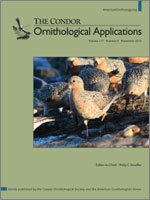Common Loons (Gavia immer) appear to use physical habitat, human disturbance, and social cues when selecting territories; however, recent loon habitat models suggest that the importance of each of these cues may vary depending on population density. We conducted loon detection surveys on lakes (n = 42) in the Lower Peninsula of Michigan, USA, during 2007–2008, and developed territory occupancy and nest success models. We found that occupancy was positively associated with lake area and the presence of islands, whereas road density (human disturbance) and the number of loon pairs within 10 km (social cue) were not important predictors of occupancy. Similarly, loon nest success was positively associated with lake area and the presence of islands. Both models performed well when applied to an independent dataset of 85 lakes (AUC = 0.743 and 0.724, respectively), indicating that these models could be used for identifying suitable habitat during conservation efforts. Our results suggest that managers should first focus efforts on maintaining or creating nesting islands on lakes, and then assess regional loon occupancy rates once physical habitat conditions are met. Comparing our results with recent loon habitat models, we suggest that social cue covariates are most important at low population densities, whereas physical habitat covariates are dominant predictors of occupancy at higher population densities of loons. Loon response to human disturbance appears to be location-specific, depending on the level of human development around lakes and local conservation efforts, particularly the provision of artificial nest platforms.
How to translate text using browser tools
30 September 2015
Physical, human disturbance, and regional social factors influencing Common Loon occupancy and reproductive success
Maxwell Field,
Thomas M. Gehring
ACCESS THE FULL ARTICLE

The Condor
Vol. 117 • No. 4
November 2015
Vol. 117 • No. 4
November 2015
common loon
Gavia immer
habitat model
human disturbance
occupancy
physical habitat
social cue




